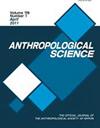Ritual consumption and sacrifice of llama (Lama grama) at the Pacopampa site in the Northern Highlands, Peru
IF 0.8
4区 社会学
Q3 EVOLUTIONARY BIOLOGY
引用次数: 4
Abstract
Domesticated camelids spread to Peru’s Northern Highlands by 500 BC. The complexity and development of the society that then developed in the region have been explained by social networks enabled by the use of the llama as a cargo animal. However, the actual use of domesticated camelids in the Formative Period remains unclear. This study analyzed camelid skeletal remains excavated from the Pacopampa site (1200–400 BC) to provide information on the actual use of these animals. Osteometry determined the camelid to be llama; alpaca was not identified in the samples. Body part frequency, butch ering mark distribution, and mortality profile revealed ritual consumption of the meaty part of young individuals. Four sacrificed immature llamas were detected. In contrast to the great similarity with the consumption process of artiodactyls’only llamas were sacrificed, while deer were not targeted. Although there were no features in the animal bone material indicating the use of secondary products, the increas ing number of artifacts related to textile production suggest the fiber might be the result of llama herding.在秘鲁北部高地的Pacopampa遗址,骆马(Lama grama)的仪式消费和牺牲
公元前500年,驯化的骆驼传播到了秘鲁的北部高地。当时该地区社会的复杂性和发展可以用使用美洲驼作为货运动物的社会网络来解释。然而,驯化骆驼在形成时期的实际用途仍不清楚。这项研究分析了从Pacopampa遗址(公元前1200-400年)出土的骆驼骨骼遗骸,以提供这些动物实际使用的信息。骨量测定确定骆驼属羊驼;在样本中没有发现羊驼。身体部位频率、男性标记分布和死亡率分布揭示了年轻人对肉质部分的仪式性消费。共发现4只未成熟大羊驼。与偶蹄目动物的消费过程非常相似的是,他们只宰杀羊驼,不宰杀鹿。尽管动物骨骼材料中没有显示使用二次产品的特征,但与纺织品生产相关的人工制品数量的增加表明,这些纤维可能是羊驼放牧的结果。
本文章由计算机程序翻译,如有差异,请以英文原文为准。
求助全文
约1分钟内获得全文
求助全文
来源期刊

Anthropological Science
生物-进化生物学
CiteScore
1.50
自引率
0.00%
发文量
7
审稿时长
>12 weeks
期刊介绍:
Anthropological Science (AS) publishes research papers, review articles, brief communications, and material reports in physical anthropology and related disciplines. The scope of AS encompasses all aspects of human and primate evolution and variation. We welcome research papers in molecular and morphological variation and evolution, genetics and population biology, growth and development, biomechanics, anatomy and physiology, ecology and behavioral biology, osteoarcheology and prehistory, and other disciplines relating to the understanding of human evolution and the biology of the human condition.
 求助内容:
求助内容: 应助结果提醒方式:
应助结果提醒方式:


